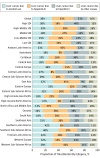The Burden of Primary Liver Cancer and Underlying Etiologies From 1990 to 2015 at the Global, Regional, and National Level: Results From the Global Burden of Disease Study 2015
- PMID: 28983565
- PMCID: PMC5824275
- DOI: 10.1001/jamaoncol.2017.3055
The Burden of Primary Liver Cancer and Underlying Etiologies From 1990 to 2015 at the Global, Regional, and National Level: Results From the Global Burden of Disease Study 2015
Abstract
Importance: Liver cancer is among the leading causes of cancer deaths globally. The most common causes for liver cancer include hepatitis B virus (HBV) and hepatitis C virus (HCV) infection and alcohol use.
Objective: To report results of the Global Burden of Disease (GBD) 2015 study on primary liver cancer incidence, mortality, and disability-adjusted life-years (DALYs) for 195 countries or territories from 1990 to 2015, and present global, regional, and national estimates on the burden of liver cancer attributable to HBV, HCV, alcohol, and an “other” group that encompasses residual causes.
Design, Settings, and Participants: Mortality was estimated using vital registration and cancer registry data in an ensemble modeling approach. Single-cause mortality estimates were adjusted for all-cause mortality. Incidence was derived from mortality estimates and the mortality-to-incidence ratio. Through a systematic literature review, data on the proportions of liver cancer due to HBV, HCV, alcohol, and other causes were identified. Years of life lost were calculated by multiplying each death by a standard life expectancy. Prevalence was estimated using mortality-to-incidence ratio as surrogate for survival. Total prevalence was divided into 4 sequelae that were multiplied by disability weights to derive years lived with disability (YLDs). DALYs were the sum of years of life lost and YLDs.
Main Outcomes and Measures: Liver cancer mortality, incidence, YLDs, years of life lost, DALYs by etiology, age, sex, country, and year.
Results: There were 854 000 incident cases of liver cancer and 810 000 deaths globally in 2015, contributing to 20 578 000 DALYs. Cases of incident liver cancer increased by 75% between 1990 and 2015, of which 47% can be explained by changing population age structures, 35% by population growth, and −8% to changing age-specific incidence rates. The male-to-female ratio for age-standardized liver cancer mortality was 2.8. Globally, HBV accounted for 265 000 liver cancer deaths (33%), alcohol for 245 000 (30%), HCV for 167 000 (21%), and other causes for 133 000 (16%) deaths, with substantial variation between countries in the underlying etiologies.
Conclusions and Relevance: Liver cancer is among the leading causes of cancer deaths in many countries. Causes of liver cancer differ widely among populations. Our results show that most cases of liver cancer can be prevented through vaccination, antiviral treatment, safe blood transfusion and injection practices, as well as interventions to reduce excessive alcohol use. In line with the Sustainable Development Goals, the identification and elimination of risk factors for liver cancer will be required to achieve a sustained reduction in liver cancer burden. The GBD study can be used to guide these prevention efforts.
Conflict of interest statement
Figures


Similar articles
-
Addressing the global cirrhosis epidemic: one size will not fit all.Lancet Gastroenterol Hepatol. 2020 Mar;5(3):230-231. doi: 10.1016/S2468-1253(19)30382-6. Epub 2020 Jan 22. Lancet Gastroenterol Hepatol. 2020. PMID: 31981522 No abstract available.
-
The trends in incidence of primary liver cancer caused by specific etiologies: Results from the Global Burden of Disease Study 2016 and implications for liver cancer prevention.J Hepatol. 2019 Apr;70(4):674-683. doi: 10.1016/j.jhep.2018.12.001. Epub 2018 Dec 11. J Hepatol. 2019. PMID: 30543829
-
Attributable liver cancer deaths and disability-adjusted life years in China and worldwide: profiles and changing trends.Cancer Biol Med. 2024 Jul 16;21(8):679-91. doi: 10.20892/j.issn.2095-3941.2024.0149. Cancer Biol Med. 2024. PMID: 39015006 Free PMC article.
-
Environmental contributions to gastrointestinal and liver cancer in the Asia-Pacific region.J Gastroenterol Hepatol. 2018 Jan;33(1):111-120. doi: 10.1111/jgh.14005. J Gastroenterol Hepatol. 2018. PMID: 28960448 Review.
-
[Alcohol and hepatitis C virus: the return of hepatotropic viruses].Gastroenterol Clin Biol. 1994;18(2):105-9. Gastroenterol Clin Biol. 1994. PMID: 8013791 Review. French. No abstract available.
Cited by
-
GLYAT suppresses liver cancer and clear cell renal cell carcinoma progression by downregulating ROCK1 expression.Transl Cancer Res. 2024 Sep 30;13(9):5097-5111. doi: 10.21037/tcr-24-1412. Epub 2024 Sep 27. Transl Cancer Res. 2024. PMID: 39430840 Free PMC article.
-
Risk stratification of HCC occurrence after HCV eradication: a complicate plot of risk factors related and unrelated to the previous viral disease.Hepatobiliary Surg Nutr. 2020 Aug;9(4):511-513. doi: 10.21037/hbsn.2019.11.27. Hepatobiliary Surg Nutr. 2020. PMID: 32832506 Free PMC article. No abstract available.
-
Sorafenib and Mesenchymal Stem Cell Therapy: A Promising Approach for Treatment of HCC.Evid Based Complement Alternat Med. 2020 Jun 14;2020:9602728. doi: 10.1155/2020/9602728. eCollection 2020. Evid Based Complement Alternat Med. 2020. PMID: 32617114 Free PMC article.
-
Change in the Recurrence Pattern and Predictors over Time after Complete Cure of Hepatocellular Carcinoma.Gut Liver. 2021 May 15;15(3):420-429. doi: 10.5009/gnl20101. Gut Liver. 2021. PMID: 32839362 Free PMC article.
-
Serum CYFRA 21-1 and CK19-2G2 as Predictive Biomarkers of Response to Transarterial Chemoembolization in Hepatitis C-related Hepatocellular Carcinoma Among Egyptians: A Prospective Study.J Clin Exp Hepatol. 2025 Jan-Feb;15(1):102405. doi: 10.1016/j.jceh.2024.102405. Epub 2024 Aug 17. J Clin Exp Hepatol. 2025. PMID: 39309220
References
-
- GBD 2015 Mortality and Causes of Death Collaborators . Global, regional, and national life expectancy, all-cause mortality, and cause-specific mortality for 249 causes of death, 1980-2015: a systematic analysis for the Global Burden of Disease Study 2015. Lancet. 2016;388(10053):1459-1544. doi:10.1016/S0140-6736(16)31012-1 - DOI - PMC - PubMed
-
- International Agency for Research on Cancer . Known causes and prevention of human cancer by organ site. August 2016. http://monographs.iarc.fr/ENG/Publications/OrganSitePoster.pdf. Accessed August 7, 2017.
MeSH terms
Grants and funding
LinkOut - more resources
Full Text Sources
Other Literature Sources
Medical

